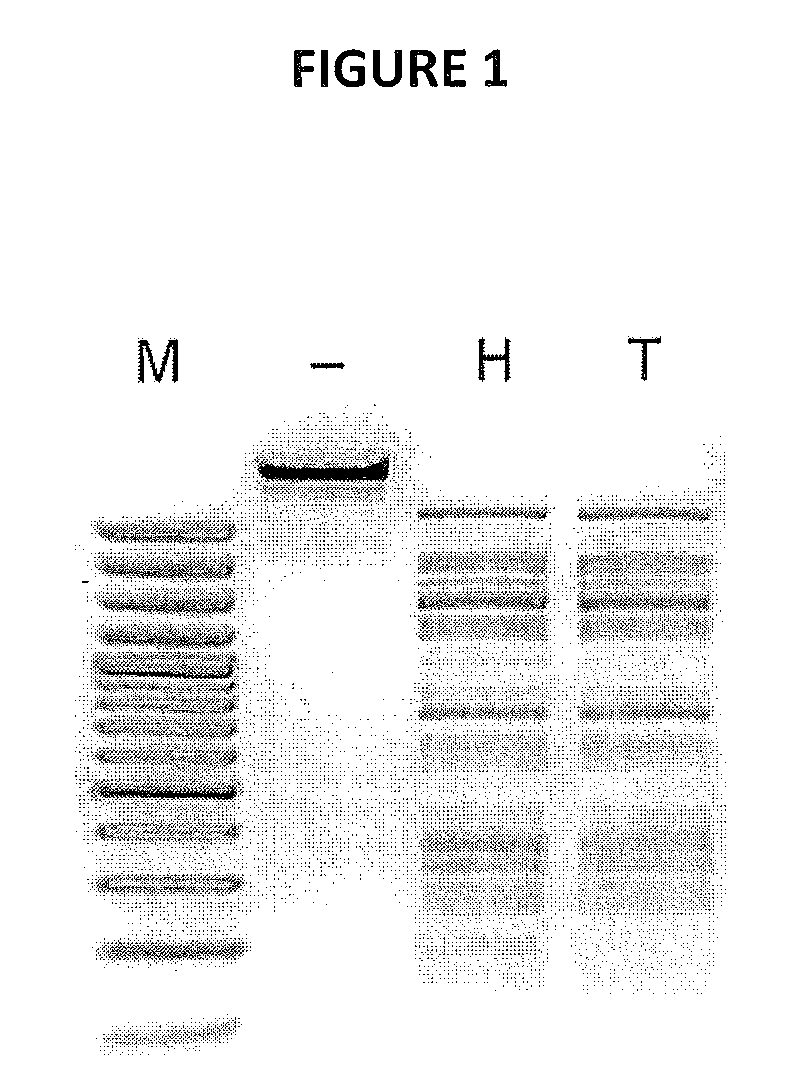Restriction endonucleases and their uses
a technology of restriction endonucleases and endonucleases, applied in the field of cytosine modification sensitive, can solve problems such as affecting the interpretation of cpg methylation status in the target sequen
- Summary
- Abstract
- Description
- Claims
- Application Information
AI Technical Summary
Benefits of technology
Problems solved by technology
Method used
Image
Examples
example 1
Restriction Endonuclease HpyF30I
Cloning of Restriction Endonuclease HpyF30I from Helicobacter pylori RFL30 Strain
[0077]The gene of HpyF30I restriction endonuclease (REBASE Enz Num 4343) was PCR amplified from H. pylori strain RFL30 genomic DNA template using pair of primers, Tq-hpR-dir (GCTATTTAAATGCAATTTTTAAATCAATCTTTGGGAT (SEQ ID No: 1)) and Tq-hpR-rev (ATAGCGGCCGCTTATGCAAGATGGTTTTCCCAAG (SEQ ID No: 2)), designed according to the sequence information of Helicobacter pylori strain 26695, i.e. the primers were complementary to the 5′ and 3′ ends of HP0261 ORF. The HP0261 ORF is adjacent to the gene HP0260. Gene HP0260 (hpyF30IM) has previously been found to encode a TCGA-specific methyltransferase M.HpyAORF260 (Vitkute et al. 2001). A pair of primers designed to be complementary to the 5′ and 3′ ends of gene encoding DNA methyltransferase M.HpyAORF260 from Helicobacter pylori 26695 strain, and which were used to amplify the hpyF30IM gene from H. pylori RFL30 strain are Tq-hpM-dir1 (...
example 2
Methylation Sensitivity of HpyF30I Restriction Endonuclease
[0084]The M.HpyF30I is putative m6A methyltransferase of TCGA specificity. Because E. coli DNA in vivo methylated with M.HpyF30I is completely protected against cleavage of HpyF30I, it was deduced that restriction endonuclease is sensitive to m6A modification in TCGA recognition sequence. Restriction endonuclease HpyF30I sensitivity to m6A modification was directly confirmed in DNA digestion experiment with overlapping Dam methylation (FIG. 3). Dam methylation target GATC may overlap the HpyF30I recognition target TCGA in the context of TC sequence. pSEAD8 plasmid DNA, which contains 11 TCGA sequences, one of them overlapping with dam sequence in one strand and the other one in both DNA strands was purified from E. coli dam+ strain JM109 and digested with TaqI restriction endonuclease (sensitive to m6A modification) and HpyF30I. DNA cleavage pattern was identical for both enzymes and differed from cleavage pattern of pSEAD8 ...
example 3
The Interrogation of DNA Methylation Level within TCGA Target in Human Jurkat Cell Line Genomic DNA Using HpyF30I and TaqI Restriction Endonucleases
Spiked PCR Fragment Digestion Analysis in the Presence of Human Jurkat Cell Line Genomic DNA
[0092]Suitability of HpyF30I and TaqI restriction endonucleases for methylation analysis of genomic DNA was first evaluated using either methylated or unmethylated DNA as a spike control together with constant amount (0.5 μg) of human Jurkat cell line genomic DNA. The PCR fragment which was amplified from lambda DNA in presence of either 100% of dCTP or dm5CTP in reaction mixtures subsequently was used as qPCR amplicon to evaluate digestion efficiency by HpyF30I and TaqI restriction endonucleases in the presence of genomic DNA (FIGS. 7A to 7C). Methylated DNA was completely resistant to HpyF30I cleavage (100% of residual DNA target amplification after restriction reaction) meanwhile only minor amounts of undigested target were detected (0.7%) afte...
PUM
| Property | Measurement | Unit |
|---|---|---|
| volume | aaaaa | aaaaa |
| structure | aaaaa | aaaaa |
| frequency | aaaaa | aaaaa |
Abstract
Description
Claims
Application Information
 Login to View More
Login to View More - R&D
- Intellectual Property
- Life Sciences
- Materials
- Tech Scout
- Unparalleled Data Quality
- Higher Quality Content
- 60% Fewer Hallucinations
Browse by: Latest US Patents, China's latest patents, Technical Efficacy Thesaurus, Application Domain, Technology Topic, Popular Technical Reports.
© 2025 PatSnap. All rights reserved.Legal|Privacy policy|Modern Slavery Act Transparency Statement|Sitemap|About US| Contact US: help@patsnap.com



